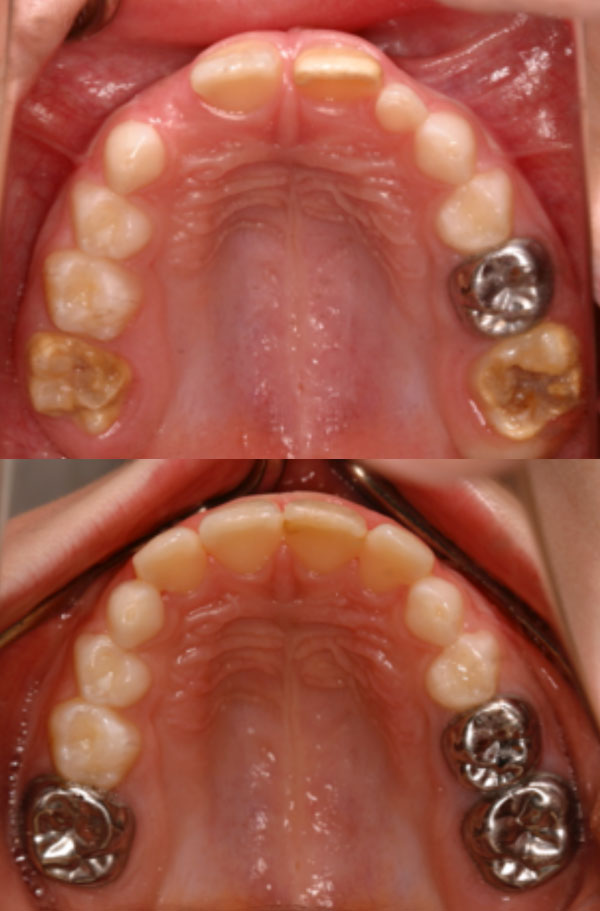Tooth Enamel Defects – 3 Treatment Options
Tooth Enamel Defects Clayton :: Tooth enamel is a semi translucent outer layer of the teeth. It is the hardest substance in our body but enamel does not contain any living cells, so it cannot restore itself if it was removed. It is the most highly mineralized structure in our body and is a very important element in protecting our teeth from decay.
Tooth Enamel Defects can occur in both baby teeth (primary) and adult teeth (permanent). The formation of enamel is sensitive to any disturbances or disorders. Enamel defects on primary teeth can result from issues occurring from the third month of pregnancy and enamel defects on permanent teeth can be from factors occurring at birth or soon after birth.
Many risk factors have been linked to enamel defects in primary and permanent teeth. The most common include:
- Health of the mother during pregnancy (eg. Illness or dietary deficiency).
- Premature birth.
- Difficult birth.
- Medications taken by the mother whilst pregnant or by the young child.
- Early childhood diseases which cause a high fever, including viral infections, pneumonia and middle-ear infections)
- Chronic or frequent illness to the young child, below four years of age.
- Poor childhood nutrition/diet deficiency
- Trauma (a knock) to the mouth can cause localised enamel defects on the primary teeth or developing permanent teeth.
The most common teeth to be affected are the second primary molars which erupt at around the age of 2½ years or in the permanent teeth the first permanent molars which erupt at age 6. The presence of enamel defects on primary teeth can, but do not always translate to defects on the permanent teeth.
Amelogenesis imperfecta: An inherited condition where every permanent and primary tooth is affected and has an abnormal enamel development. This condition can look similar to Molar-incisor hypomineralisation (MIH).
There are 3 types of enamel defects:
- Enamel hypoplasia
- Molar-incisor hypomineralisation (MIH)
- Enamel opacities

Enamel hypoplasia
Enamel hypoplasia is when there is a reduced amount of enamel than normal. The lesions are usually localized and appear a pitting or grooves on the tooth surface. In severe cases the tooth has no enamel, exposing the dentin.

Molar-incisor hypomineralisation (MIH)
Molar Incisor Hypomineralisation (MIH) affects the enamel of the permanent teeth, causing the teeth to be soft and discoloured. The cause of MIH is unknown. It usually affects the first permanent molars and incisor. It presents itself as a creamy, yellow or brown colour, usually with a rough texture that can chip away very easily.
MIH affected teeth are often sensitive to cold and are at a higher risk of developing dental decay.

Enamel opacities
Enamel opacities are found on or below the tooth surface. The tooth can often stand out because the affected area can be opaque, white, yellow or brown in colour. They can range from being discrete to being very widespread.
Treatment options
Fluoride treatment
Fluoride treatments are a great way to strengthen the enamel, protect against decay and reduce sensitivity in both primary and permanent teeth. There are many fluoride treatments out there including the most common:
Fluoride Varnish/Gel- A specially made tray is filled with a fluoride gel and inserted for a period of time into the mouth covering all the teeth. A fluoride varnish can be applied to the teeth by a dentist.
Fluoride rinse- A fluoride rinse may be suggested as a daily or weekly treatment for children 6 or over (this ensures they are able to spit out properly, as it is not to be swallowed).
Desensitizing options
Tooth Mousse™– Tooth mousse is a milk-derived protein that contains high concentrations of the minerals calcium and phosphate, these minerals help bind to the teeth. This protects, strengthens and helps provide relief from sensitivity. Tooth Mousse™ can be applied directly or applied into a custom made tray to the affected teeth to prevent decay and manage sensitivity. Tooth mousse comes in a range of yummy flavors which is great for fussy children.
Restoration options
As the weakened/lack of enamel may cause decay or a discoloration in the tooth surface and structure, your dentist may suggest these restorative options for you:
Direct tooth coloured– An adhesive tooth coloured restoration (white filling) can be bonded directly onto the tooth’s surface to cover the enamel defected area.
Veneer- A porcelain material, prepared by a trusted laboratory, fits over and covers the surface of the tooth. The colour of the veneer can be matched in perfectly with the tooth/teeth beside. The dentist will then bond the veneer onto the tooth.
Crown- A crown fits over the existing natural tooth and is designed to repair and reinforce teeth that have been severely weakened by decay, enamel defects or have had a root canal treatment. They can also enhance the appearance or function of the tooth depending on the position of the tooth being crowned.
